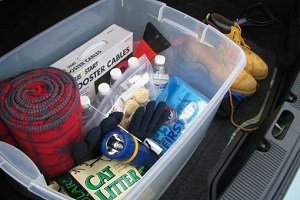With these bitter temperatures, beware of hypothermia and frostbite.
Frostbite can occur on exposed skin in less than 10 minutes. Symptoms include a loss of feeling and a white or pale appearance in fingers, toes, ear tips, and tip of the nose. Limit your time outside. If you see these signs, seek medical care immediately!
Signs of hypothermia include shivering, exhaustion, confusion, fumbling hands, memory loss, slurred speech, and drowsiness in adults and children. In infants, symptoms can include bright red or cold skin and very low energy. If you notice anyone exhibiting any of the symptoms of hypothermia, seek medical care immediately!
Carbon Monoxide Danger
Furnaces, fireplaces, wood stoves, and kerosene heaters will be hard at work during these extremely cold temperatures. While these home heating devices can keep the cold at bay, they also increase the risk of carbon monoxide poisoning.
Carbon monoxide (CO) is the leading cause of accidental poisoning deaths in the United States. Breathing carbon monoxide displaces the oxygen in the blood and can cause death within minutes at high levels. Symptoms of overexposure to carbon monoxide are often mistaken for the flu and include headaches, fatigue, dizziness, shortness of breath/chest pain, nausea/vomiting, and confusion. If you or someone you know experience any of these symptoms, or if your carbon monoxide detector sounds an alarm, head outside immediately for fresh air and call 911.
Never run a gasoline or propane heater or a grill (gas or charcoal) inside your home or an unventilated garage. Any heating system that burns fuel will produce carbon monoxide. Never run a car in an enclosed space. If a vehicle is running, you must have a door open to the outside. Run generators a safe distance from the home – never in the home or garage or right next to windows or doors. Make sure you have a working carbon monoxide detector.
Frozen Pipes
Extreme cold can freeze water pipes inside and outside homes. Here are some tips how to prevent frozen pipes and how to thaw them out. Also see our comprehensive guide to shutting off household utilities.
Learn More
More information about dealing with severe cold weather is available from the following sources:
- Federal Emergency Management Agency (FEMA)
- Centers for Disease Control (CDC)
- American Association of Pediatricians (APA)
- National Oceanic and Atmospheric Administration (NOAA)
Winter Travel Tips
If you are traveling, make sure you have a winter emergency kit in your vehicle. Items to include in the kit are candles and matches, a flashlight, pocket knife, snacks, a cell phone adapter, a blanket and extra clothing. Check with Kentucky 511 for the latest road conditions: visit http://511.ky.gov/
 Visit our vehicle emergency kit page for more information.
Visit our vehicle emergency kit page for more information.
For the Kentucky Transportation Cabinet’s current winter weather response status, visit 511.ky/gov/winteractivities/. You also can view the snow and ice removal priority map for your county.
Pet Precautions
While our pets might seem to have built-in warm winter coats, they too are sensitive to the elements. Bring them indoors during this bitter weather. Dogs and cats can get frostbitten ears, noses, and feet if left outside. Chemicals used to melt snow and ice can also irritate pets’ paws. Be sure to keep antifreeze, salt, and other poisons away from pets.
Cats sometimes crawl under cars and into the engine compartment, seeking shelter and warmth. Before starting the engine on cold days, bang on the hood to startle sleeping animals. Remember that just as cars heat to oven temperature in summer, they can be equally deadly in winter when they turn into freezers. Don’t leave your pet alone in a vehicle. It may freeze to death.
Livestock Precautions
Animals can suffer from hypothermia, frostbite, and other cold weather injuries. Harsh conditions weaken their immune systems and open the door to illness. Calves and swine are especially susceptible to cold. Calves can have undetected pneumonia that can kill quickly when cold weather arrives. Animals that have recently arrived from a warmer climate, or that have been indoors and are now outdoors, may not be acclimated to local weather and can suffer more winter illnesses.
Make sure animals have a place to get out of the wind and moisture, even if it is just a windbreak or a three-sided shelter. Also provide dry bedding to protect them from frostbite. Animals burn extra calories to keep warm in severe cold, so they need extra nutrition. They also need access to fresh water – not frozen streams or snow. Stock tank heaters and frost-proof watering devices will ensure that livestock get enough to drink.
